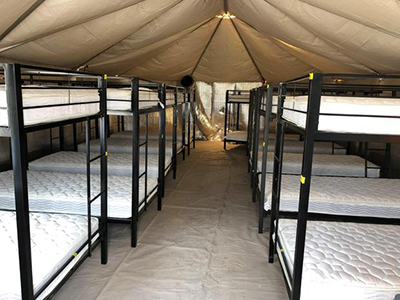Detained immigrant children are being moved to a tent city in Texas

Photo of the interior of one of the tents in Tornillo, Texas, released in June by the U.S. Department of Health and Human Services.
Hundreds of immigrant children in federal custody are being moved to a tent city erected in the Texas desert during the family separation policy, the New York Times reported Sunday.
The government is moving children to the tent city outside El Paso because the conventional shelters for unaccompanied minors are consistently around 90 percent full, the Times says. There are more than 13,000 detained minors overall, it says—five times larger than last year, the newspaper says. Those minors are also staying in federal custody longer, at an average of 59 days, up from 34 days in 2017.
So far, more than 1,600 minors have been moved to Tornillo, the newspaper says—often in the middle of the night, when they’re given backpacks and snacks for their journeys. Most are truly unaccompanied minors, not minors separated from their parents under the family separation policy the Trump administration pursued this summer. They come from roughly 100 state-licensed shelters across the United States, where they live two or three to a room and have access to regular schooling and legal assistance.
By contrast, the tent city in Tornillo is unregulated and does not offer schooling, although the kids are given workbooks. (This may violate the Flores settlement, which governs how unaccompanied minors are to be treated in federal custody.) Access to legal services is limited; Google Maps says Tornillo is a forty-minute drive from El Paso, the nearest American city of any size. The population of Tornillo in the 2010 census was 1,568 residents. The children live in air-conditioned, gender-separated tents with bunks for up to 20 kids at a time. The shelter’s total capacity was expanded in September to 3,800, and federal authorities expect it to be open through the end of the year.
A spokeswoman for the Department of Health and Human Services says the shelter is an “influx shelter” designed to accommodate a sudden increase in demand, much like the shelters erected on military bases during the 2014 “surge” of unaccompanied minors. They are intended to be temporary, which is why the residents are mainly older kids who are expected to be released soon.
“The number of families and unaccompanied alien children apprehended are a symptom of the larger problem, namely a broken immigration system,” HHS spokeswoman Evelyn Stauffer told the Times. “Their ages and the hazardous journey they take make unaccompanied alien children vulnerable to human trafficking, exploitation and abuse. That is why HHS joins the president in calling on Congress to reform this broken system.”
Several anonymous shelter workers told the Times that the kids are moved in the middle of the night, without advance warning, to prevent them from trying to escape. They wear belts with the phone numbers of their emergency contacts written on them. Some of the shelter staff members cried after learning what would happen to their charges, one worker said.
Leah Chavala of the Women’s Refugee Commission told the Times that this can’t be the right solution.
“Obviously we have concerns about kids falling through the cracks, not getting sufficient attention if they need attention, not getting the emotional or mental health care that they need,” she said.
The increased demand for shelters is not because border crossings have increased, the Times notes; rather, it comes from new Trump administration policies that make it harder to sponsor a child and easier for sponsors who are undocumented themselves to be arrested. An ICE official testified to Congress in late September that ICE had arrested dozens of adults who’d applied to sponsor a minor; 70 percent of those arrested had no criminal record.



